Complete Goss Secondary Recrystallization by Control of the Grain Size and Texture of Primary Recrystallization in Grain-Oriented Silicon Steel
Abstract
:1. Introduction
2. Materials and Methods
3. Results
3.1. Microstructure, Texture and Inhibitor in the Rolling and Primary Recrystallization Strips
3.2. Evolution of Microstructure and Properties during Secondary Recrystallization
4. Discussion
4.1. Formation and Evolution Mechanism of the Island Grains
4.2. AGG of Goss under the Influence of Multi-Factors
5. Conclusions
- The present work produced Fe-3.25 wt.% Si strips with more favorable magnetic properties successfully. After the two-stage normalized annealing, the grain size in different layers of the primary recrystallized matrix was more homogeneous, and the grain size distribution of the main texture components, i.e., {111}<112> and {114}<481>, also showed a similar state. This not only enabled the secondary recrystallization of Goss-oriented grains to be completed efficiently, but also facilitates the complete elimination of island grains, leaving no island grains in the final products.
- The mechanisms of formation and evolution for island grains during the AGG of Goss are investigated. It is concluded that the main reason for the formation of island grains is related to the size of matrix grains, and the elimination of these grains is attributed to the characteristics of grain boundaries.
- A comprehensive analysis of Goss AGG is carried out under the influence of grain size and texture in the primary recrystallization matrix. It is considered that the effect of favorable texture components needs to be coordinated and controlled by the factor of grain size. In this way, the stable and highly efficient control of secondary recrystallization of sharp Goss oriented-grains can be realized.
Author Contributions
Funding
Institutional Review Board Statement
Informed Consent Statement
Data Availability Statement
Conflicts of Interest
References
- Goss, N.P. Electrical Sheet and Method and Apparatus for Its Manufacture and Test. U.S. Patent 1965559, 3 July 1934. [Google Scholar]
- Hayakawa, Y. Mechanism of secondary recrystallization of Goss grains in grain-oriented electrical steel. Sci. Technol. Adv. Mater. 2017, 18, 480–497. [Google Scholar] [CrossRef]
- Xia, Z.; Kang, Y.; Wang, Q. Developments in the production of grain-oriented electrical steel. J. Magn. Magn. Mater. 2008, 320, 3229–3233. [Google Scholar] [CrossRef]
- Hillert, M. On the theory of normal and abnormal grain growth. Acta Metall. 1965, 13, 227–238. [Google Scholar] [CrossRef]
- Chen, N.; Zaefferer, S.; Lahn, L.; Günther, K.; Raabe, D. Effects of topology on abnormal grain growth in silicon steel. Acta Mater. 2003, 51, 1755–1765. [Google Scholar] [CrossRef]
- Song, H.-Y.; Wang, Y.-P.; Esling, C.; Wang, G.-D.; Liu, H.-T. The role of grain colony on secondary recrystallization in grain-oriented electrical steel: New insights from an original tracking experiment. Acta Mater. 2021, 206, 116611. [Google Scholar] [CrossRef]
- Harase, J.; Shimizu, R. Distribution of {110} oriented grains in the primary recrystallized 3% Si-Fe alloy. Trans. Jpn. Inst. Met. 1988, 29, 388–398. [Google Scholar] [CrossRef] [Green Version]
- Hayakawa, Y.; Szpunar, J.; Palumbo, G.; Lin, P. The role of grain boundary character distribution in Goss texture development in electrical steels. J. Magn. Magn. Mater. 1996, 160, 143–144. [Google Scholar] [CrossRef]
- Hwang, N.M. Simulation of the effect of anisotropic grain boundary mobility and energy on abnormal grain growth. J. Mater. Sci. 1998, 33, 5625–5629. [Google Scholar] [CrossRef]
- Birosca, S.; Nadoum, A.; Hawezy, D.; Robinson, F.; Kockelmann, W. Mechanistic approach of Goss abnormal grain growth in electrical steel: Theory and argument. Acta Mater. 2020, 185, 370–381. [Google Scholar] [CrossRef]
- Xu, Z.Y.; Sha, Y.H.; Zhang, F.; Zhang, H.B.; Li, G.B.; Chu, S.J.; Zuo, L. Orientation selection behavior during secondary recrystallization in grain-oriented silicon steel. Acta Metall. Sin. 2020, 56, 1067–1074. [Google Scholar]
- Ushigami, Y.; Kawasaki, K.; Nakayama, T.; Suga, Y.; Harase, J. Dynamic Observation of the Growth of Secondary Recrystallized Grains of Fe-3% Si Alloy Utilizing Synchrotron X-Ray Topography. Mater. Sci. Forum 1994, 157–162, 1081–1086. [Google Scholar] [CrossRef]
- Ushigami, Y. Theoretical analysis and computer simulation of secondary recrystallization in grain-oriented silicon steel. Nippon Steel Techn. Rep. 2013, 102, 25–30. [Google Scholar]
- Etter, A.; Baudin, T.; Penelle, R. Influence of the Goss grain environment during secondary recrystallisation of conventional grain oriented Fe–3%Si steels. Scr. Mater. 2002, 47, 725–730. [Google Scholar] [CrossRef]
- Maazi, N.; Rouag, N.; Etter, A.; Penelle, R.; Baudin, T. Influence of neighbourhood on abnormal Goss grain growth in Fe–3% Si steels: Formation of island grains in the large growing grain. Scr. Mater. 2006, 55, 641–644. [Google Scholar] [CrossRef]
- Humphreys, F.J.; Hatherly, M. Recrystallization and Related Annealing Phenomena, 2nd ed.; Elsevier: Oxford, UK, 2004. [Google Scholar]
- Ono, N.; Kimura, K.; Watanabe, T. Monte Carlo simulation of grain growth with the full spectra of grain orientation and grain boundary energy. Acta Mater. 1999, 47, 1007–1017. [Google Scholar] [CrossRef]
- Ko, K.; Rollett, A.; Hwang, N. Monte-Carlo Simulation of Goss Abnormal Grain Growth in Fe-3%Si Steel by Sub-Boundary Enhanced Solid-State Wetting. Mater. Sci. Forum 2012, 715–716, 146–151. [Google Scholar] [CrossRef]
- He, C.X.; Yang, F.Y.; Ma, G.; Chen, X.; Meng, L. {411} Texture in thin-gauge grain-oriented silicon steel. Acta Metall. Sin.-Engl. Lett. 2016, 29, 554–560. [Google Scholar] [CrossRef] [Green Version]
- Kumano, T.; Ushigami, Y. Grain Boundary Characteristics of Isolated Grains in Conventional Grain Oriented Silicon Steel. ISIJ Int. 2007, 47, 890–897. [Google Scholar] [CrossRef] [Green Version]
- Homma, H.; Nakamura, S.; Yoshinaga, N. On {h,1,1}, the Recrystallisation Texture of Heavily Cold Rolled BCC Steel. Mater. Sci. Forum 2004, 467–470, 269–274. [Google Scholar] [CrossRef]
- Liu, Z.; Yang, P.; Mao, W.; Cui, F. Effect of {114} texture on abnormal growth during secondary recrystallization in grain-oriented steel. Acta Metall. Sin. 2015, 51, 769–776. [Google Scholar]
- Liu, G.-T.; Liu, Z.-Q.; Yang, P.; Mao, W.-M. Correlation between Primary and Secondary Recrystallization Texture Components in Low-temperature Reheated Grain-oriented Silicon Steel. J. Iron Steel Res. Int. 2016, 23, 1234–1242. [Google Scholar] [CrossRef]
- Liu, Z.; Yang, P.; Li, X.; Wang, X.; Ma, J.; Liu, G. Formation of island grains in high-permeability grain-oriented silicon steel manufactured by the acquired inhibitor method. J. Phys. Chem. Solids 2020, 136, 109165. [Google Scholar] [CrossRef]
- Bennett, T.A.; Kalu, P.N.; Rollett, A.D. On the character of host-island grain interfaces in Fe-1%Si alloy. Scr. Mater. 2007, 57, 41–44. [Google Scholar] [CrossRef]
- Rajmohan, N.; Szpunar, J. An analytical method for characterizing grain boundaries around growing goss grains during secondary recrystallization. Scr. Mater. 2001, 44, 2387–2392. [Google Scholar] [CrossRef]
- Shin, S.-M.; Chang, S.-K.; De Cooman, B.C. Evolution of Texture and Related Magnetic Properties in Fe–3%Si Steel during Single-step Annealing. ISIJ Int. 2008, 48, 1788–1794. [Google Scholar] [CrossRef]
- Matsuo, M.; Sakai, T.; Suga, Y. Origin and development of through-the-thickness variations of texture in the processing of grain-oriented silicon steel. Met. Mater. Trans. A 1986, 17, 1313–1322. [Google Scholar] [CrossRef]
- Inokuti, Y.; Yanagisawa, M.; Gotoh, C. Structure of 〈110〉 Fiber Texture in the Mid-thickness of Hot-rolled Silicon Steel Sheet. Mater. Trans. JIM 1991, 32, 1128–1134. [Google Scholar] [CrossRef]
- Fukagawa, T.; Yashiki, H. Effect of Hot-band Annealing Condition on Secondary Recrystallization in Grain-oriented 2.3%Si-1.7%Mn Steel. ISIJ Int. 2000, 40, 402–408. [Google Scholar] [CrossRef]
- Kim, J.-K.; Woo, J.S.; Chang, S.K. Influence of annealing before cold rolling on the evolution of sharp Goss texture in Fe-3%Si alloy. J. Magn. Magn. Mater. 2000, 215-216, 162–164. [Google Scholar] [CrossRef]
- Chang, S.K. Influence of Hot Band Normalizing on Recrystallization Behaviour in Grain Oriented Silicon Steels. Steel Res. Int. 2005, 76, 660–665. [Google Scholar] [CrossRef]
- Chang, S. Texture change from primary to secondary recrystallization by hot-band normalizing in grain-oriented silicon steels. Mater. Sci. Eng. A 2007, 452-453, 93–98. [Google Scholar] [CrossRef]
- Bunge, H.J.; Esling, C.; Muller, J. The influence of crystal and sample symmetries on the orientation distribution function of the crystallites in polycrystalline materials. Acta Crystallogr. Sect. A Cryst. Phys. Diffr. Theor. Gen. Crystallogr. 1981, 37, 889–899. [Google Scholar] [CrossRef] [Green Version]
- Akta, S.; Richardson, G.J.; Sellars, C.M. Hot Deformation and Recrystallization of 3% Silicon: Steel Part 1: Microstructure, Flow Stress and Recrystallization Characteristics. ISIJ Int. 2005, 45, 1666–1675. [Google Scholar] [CrossRef] [Green Version]
- Lobanov, M.L.; Redikul’tsev, A.A.; Rusakov, G.M.; Danilov, S.V. Effect of carbon on texture formation in electrical steel Fe-3% Si under hot rolling. Met. Sci. Heat Treat. 2015, 56, 646–649. [Google Scholar] [CrossRef]
- Hutchinson, W.B. Development of Textures in Recrystallization. Met. Sci. 1974, 8, 185–196. [Google Scholar] [CrossRef]
- Quadir, M.Z.; Duggan, B.J. Deformation banding and recrystallization of α fiber components in heavily rolled IF steel. Acta Mater. 2004, 52, 4011–4021. [Google Scholar] [CrossRef]
- Park, J.-T.; Szpunar, J.A. Evolution of recrystallization texture in nonoriented electrical steels. Acta Mater. 2003, 51, 3037–3051. [Google Scholar] [CrossRef]
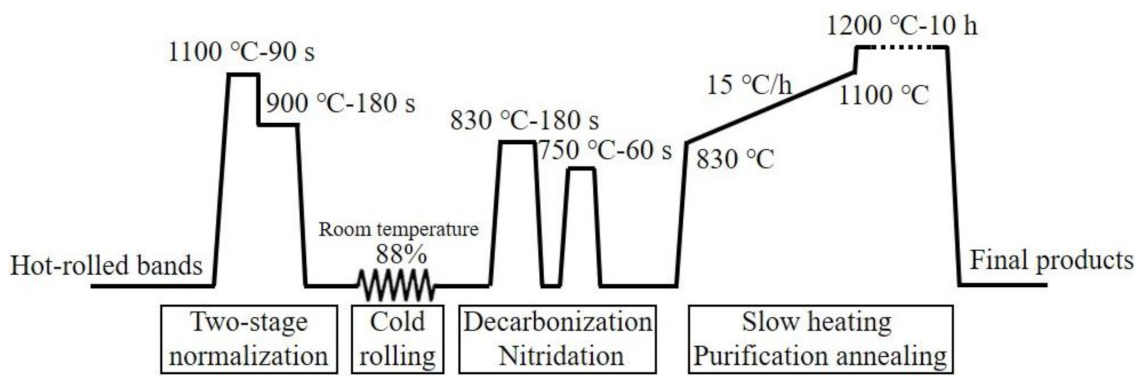

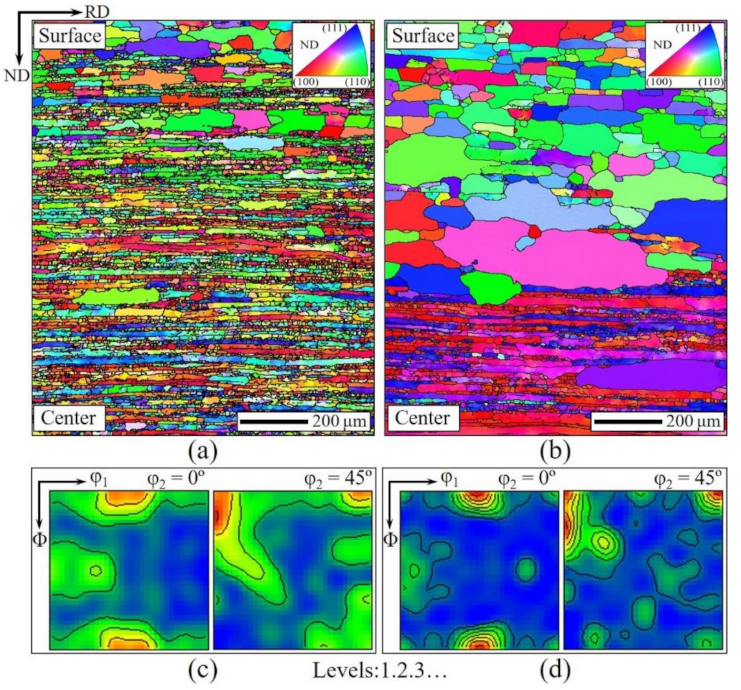
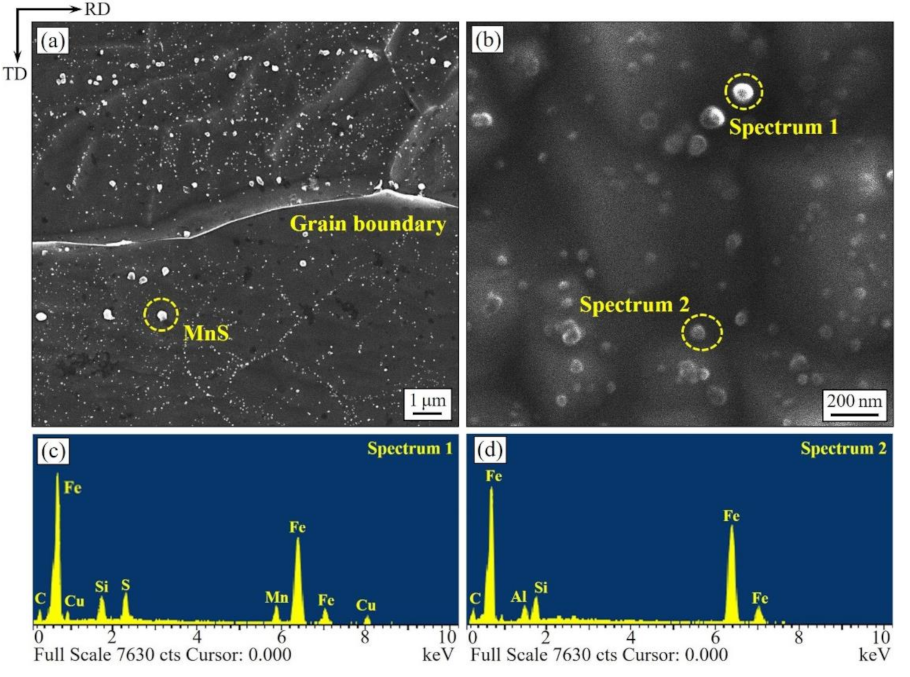
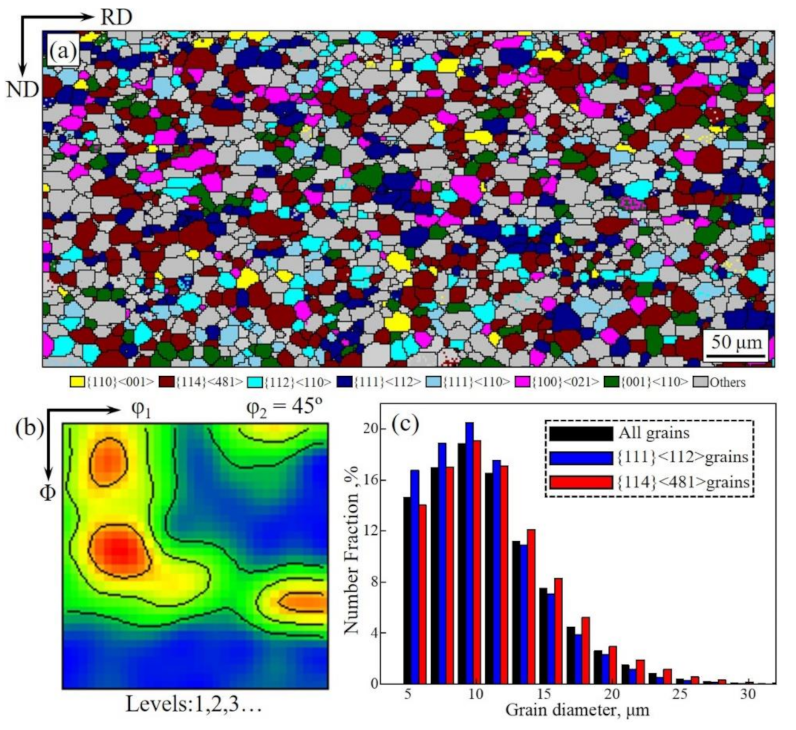
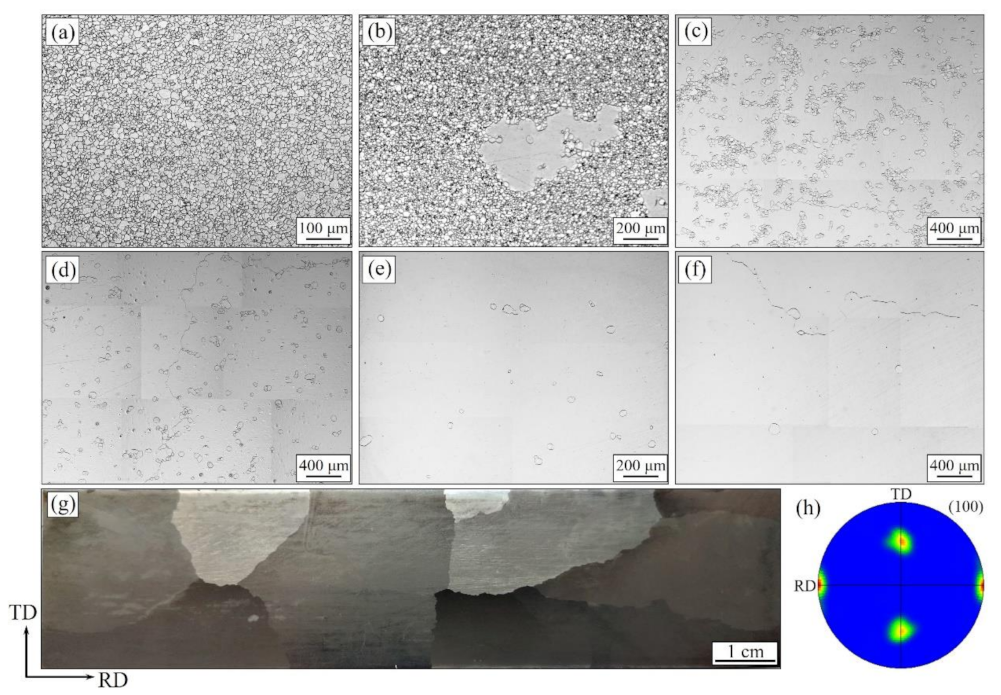
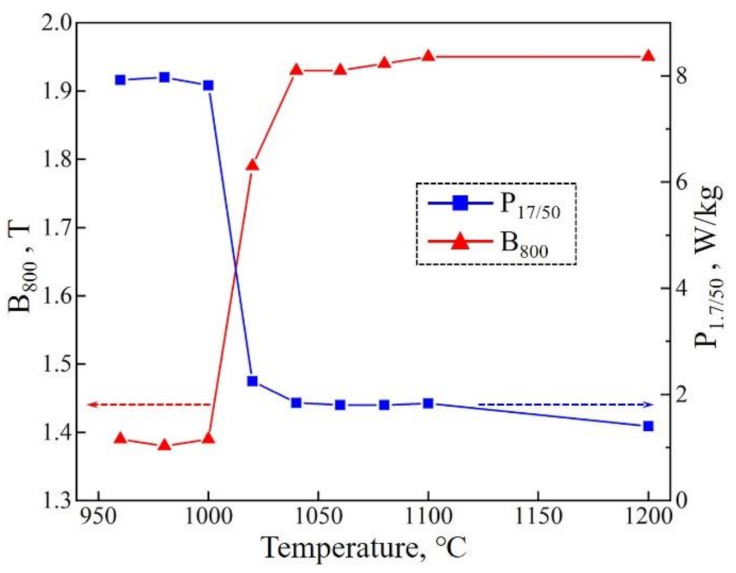




| Temperature (°C) | 1020 | 1040 | 1060 | 1080 |
|---|---|---|---|---|
| Density of Island Grains (/mm2) | 280.0 | 34.5 | 2.6 | 0.4 |
| Average Diameter of Island Grains (μm) | 29.8 | 42.3 | 63.2 | 92.3 |
Publisher’s Note: MDPI stays neutral with regard to jurisdictional claims in published maps and institutional affiliations. |
© 2021 by the authors. Licensee MDPI, Basel, Switzerland. This article is an open access article distributed under the terms and conditions of the Creative Commons Attribution (CC BY) license (https://creativecommons.org/licenses/by/4.0/).
Share and Cite
Xu, Z.; Sha, Y.; He, Z.; Zhang, F.; Liu, W.; Zhang, H.; Zuo, L. Complete Goss Secondary Recrystallization by Control of the Grain Size and Texture of Primary Recrystallization in Grain-Oriented Silicon Steel. Materials 2021, 14, 5383. https://doi.org/10.3390/ma14185383
Xu Z, Sha Y, He Z, Zhang F, Liu W, Zhang H, Zuo L. Complete Goss Secondary Recrystallization by Control of the Grain Size and Texture of Primary Recrystallization in Grain-Oriented Silicon Steel. Materials. 2021; 14(18):5383. https://doi.org/10.3390/ma14185383
Chicago/Turabian StyleXu, Zhanyi, Yuhui Sha, Zhenghua He, Fang Zhang, Wei Liu, Huabing Zhang, and Liang Zuo. 2021. "Complete Goss Secondary Recrystallization by Control of the Grain Size and Texture of Primary Recrystallization in Grain-Oriented Silicon Steel" Materials 14, no. 18: 5383. https://doi.org/10.3390/ma14185383
APA StyleXu, Z., Sha, Y., He, Z., Zhang, F., Liu, W., Zhang, H., & Zuo, L. (2021). Complete Goss Secondary Recrystallization by Control of the Grain Size and Texture of Primary Recrystallization in Grain-Oriented Silicon Steel. Materials, 14(18), 5383. https://doi.org/10.3390/ma14185383






